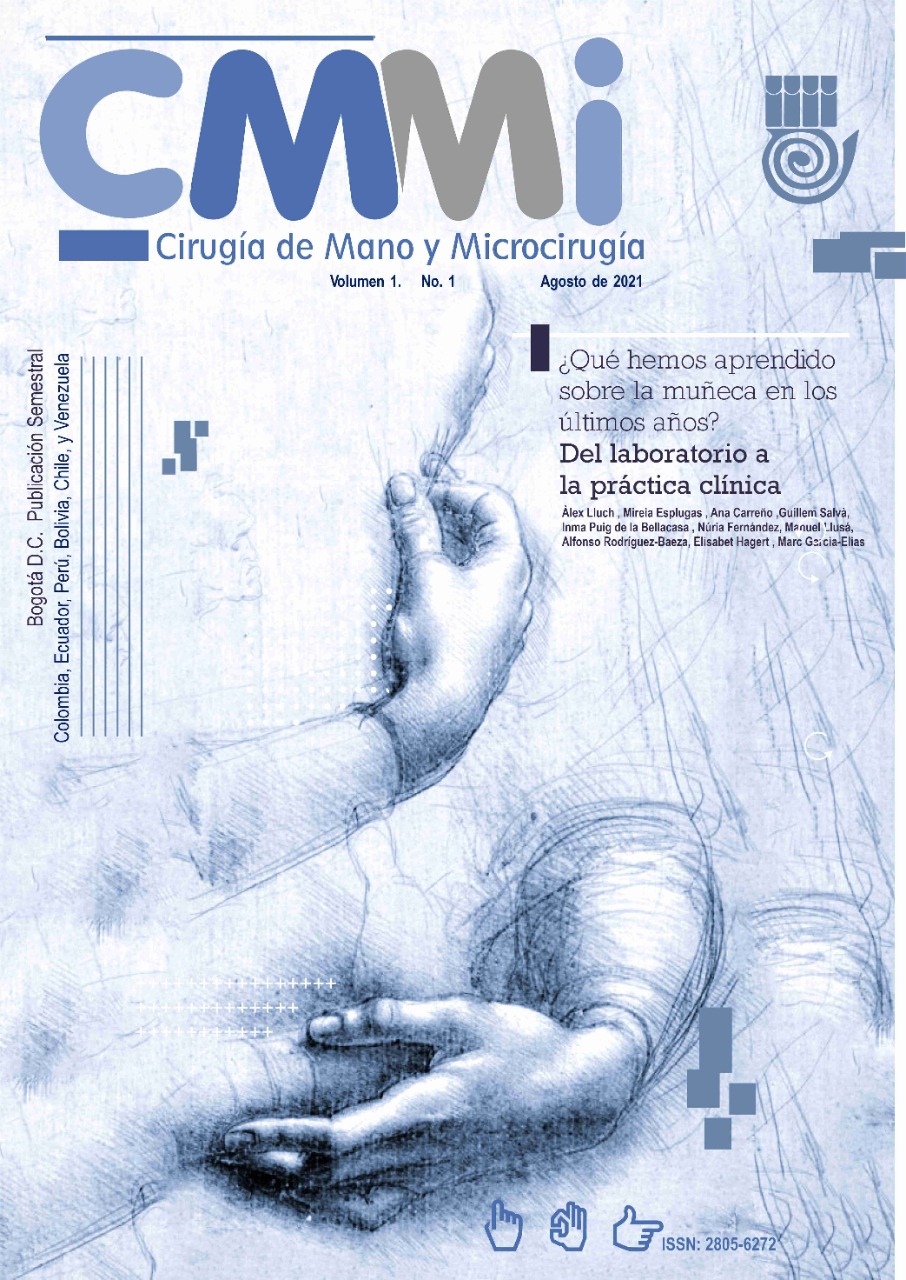Lesiones del plexo braquial en adultos. Parte 1: Anatomía, examen físico y evaluación
DOI:
https://doi.org/10.25214/28056272.1177Keywords:
Brachial plexus, Brachial Plexus Neuropathies, Peripheral Nerve InjuriesAbstract
Introduction: The Brachial plexus is an intricated network of nerves that provide motor and sensory innervation of the shoulder girdle and the upper extremity. A variety of mechanisms may injure the nerves at different locations to a variable degree. Most severely the nerves are avulsed from spinal cord resulting in global loss of function and sensation of the upper extremity.
Purpose: This paper intends to review the anatomy of the Brachial Plexus, Mechanisms and Patterns of Injury, and to provide guidelines for a structured physical examination. Additionally, the role of diagnostic and supporting studies will be reviewed.
Results: Knowledge of the anatomy of BP assists in identifying location of injury as well as treatment options. Closed traction is the most common mechanism and most of BP injuries are pan plexal at presentation. Physical examination is key in ruling out life threatening situations, diagnostic test interpretation and treatment decision making. CT Myelogram remains the gold standard in diagnostic imaging. Nerve electrophysiologic studies (EMG, NCS, SSEP/MEP) are the most reliable way of identifying nerve injury and document the earliest signs of recovery. While a variety of treatment options are available to restore function, the options chosen depend on which nerves are injured and what the exam findings are.
Conclusion: Prognosis in Brachial plexus injury lies on correct and prompt diagnosis. The multifactorial diagnosis process intends to narrow the options helping the surgeon decide the best course of treatment.
Downloads
References
Gilbert A, editor. Brachial Plexus Injuries. 2nd ed. Martin Dunitz; 2003.
Kerr AT. The brachial plexus o f nerves in man , the variations in its formations and branches. Am J Anat. 1910;23(2):285-395. DOI: 10.1002/aja.1000230205. https://doi.org/10.1002/aja.1000230205
Kim DH, Murovic JA, Tiel RL, Kline DG. Mechanisms of injury in operative brachial plexus lesions. Neurosurg Focus. 2004;16(5):E2.
Goldie BS, Coates CJ. Brachial plexus injury : a survey of incidence and referral pattern. J Hand Surg Br. 1992;1(1):86-8. DOI: 10.1016/0266-7681(92)90018-w. https://doi.org/10.1016/0266-7681(92)90018-W
Dubuisson AS, Kline DG. Brachial plexus injury: a survey of 100 consecutive cases from a single service. Neurosurgery. 2002;51(3):673-83. https://doi.org/10.1097/00006123-200209000-00011
Sunderland S. Mechanisms of cervical nerve root avulsion in injuries of the neck and shoulder. J Neurosurg. 1974;41(6):705-14. DOI: 10.3171/jns.1974.41.6.0705. https://doi.org/10.3171/jns.1974.41.6.0705
Spinner RJ, Shin AY, Elhassan BT, Bishop AT. Traumatic Brachial Plexus Injury. Green's Operative Hand Surgery. 2-Volume Set. 7th ed. Elsevier Inc; 2018. p. 1146-1207.
Shin AY, Spinner RJ. Clinically Relevant Surgical Anatomy and Exposures of the Brachial Plexus. Hand Clin. 2005;21(1):1-11. DOI: 10.1016/j.hcl.2004.09.006. https://doi.org/10.1016/j.hcl.2004.09.006
Barnes R. Traction injuries of the brachial plexus in adults. J Bone Joint Surg Br. 1949;31B(1):10-6.
Bertelli JA, Ghizoni MF. C5-8 brachial plexus root injury: the "T-1 hand". J Neurosurg. 2012;116(2):409-13. DOI: 10.3171/2011.7.JNS11672.
https://doi.org/10.3171/2011.7.JNS11672
Abul-kasim K, Backman C, Björkman A, Dahlin LB. Advanced radiological work-up as an adjunct to decision in early reconstructive surgery in brachial plexus injuries. J Brachial Plex Peripher Nerve Inj. 2010;5:14. DOI: 10.1186/1749-7221-5-14. https://doi.org/10.1186/1749-7221-5-14
Limthongthang R, Bachoura A, Songcharoen P, Osterman AL. Adult Brachial Plexus Injury Evaluation and Management. Orthop Clin North Am. 2013;44(4):591-603. DOI: 10.1016/j.ocl.2013.06.011. https://doi.org/10.1016/j.ocl.2013.06.011
Lebowitz C, Matzon JL. Arterial Injury in the Upper Extremity: Evaluation, Strategies, and Anticoagulation Management. Hand Clin. 2018;34(1):85-95. DOI: 10.1016/j.hcl.2017.09.009. https://doi.org/10.1016/j.hcl.2017.09.009
Bertelli JA, Ghizoni MF. Results and current approach for Brachial Plexus reconstruction. J Brachial Plex Peripher Nerve Inj.2011;6(1):2-8. DOI: 10.1186/1749-7221-6-2. https://doi.org/10.1186/1749-7221-6-2
Qureshi A. Diaphragm paralysis. Semin Respir Crit Care Med. 2009;30(3):315-20. DOI: 10.1055/s-0029-1222445. https://doi.org/10.1055/s-0029-1222445
Dubé BP, Dres M. Diaphragm Dysfunction: Diagnostic Approaches and Management Strategies. J Clin Med. 2016;5(12):113.DOI: 10.3390/jcm5120113. https://doi.org/10.3390/jcm5120113
Walker AT, Chaloupka JC, De Lotbiniere AC, Wolfe SW, Goldman R, Kier L. Detection of Nerve Rootlet Avulsion on CT Myelography in Patients with Birth Palsy and Brachial Plexus Injury After Trauma. AJR Am J Roentgenol. 1996;167(5):1283-8.DOI: 10.2214/ajr.167.5.8911196. https://doi.org/10.2214/ajr.167.5.8911196
Yamazaki H, Doi K, Hattori Y, Sakamoto S. Computerized tomography myelography with coronal and oblique coronal view for diagnosis of nerve root avulsion in brachial plexus injury. J Brachial Plex Peripher Nerve Inj. 2007;2:16. DOI:10.1186/1749-7221-2-16. https://doi.org/10.1186/1749-7221-2-16
Van der Linde E, Naidu V, Mitha A, Rocher A. Diagnosis of nerve root avulsion injuries in adults with traumatic brachial plexopathies: MRI compared with CT myelography. South African J Radiol. 2015;19(1):779-87. DOI: 10.4102/sajr.v19i1.779 https://doi.org/10.4102/sajr.v19i1.779
Fuzari HKB, Dornelas de Andrade A, Vilar CF, Sayão LB, Diniz PRB, Souza FH, et al. Diagnostic accuracy of magnetic resonance imaging in post-traumatic brachial plexus injuries : A systematic review. Clin Neurol Neurosurg. 2018;164:5-10. DOI:10.1016/j.clineuro.2017.11.003. https://doi.org/10.1016/j.clineuro.2017.11.003
Zhang L, Xiao T, Yu Q, Li Y, Shen F, Li W. Clinical Value and Diagnostic Accuracy of 3 . 0T Multi-Parameter Magnetic Resonance Imaging in Traumatic Brachial Plexus Injury. Med SciMonit. 2018;24:7199-205. DOI: 10.12659/MSM.907019. https://doi.org/10.12659/MSM.907019
Mansukhani KA. Electrodiagnosis in traumatic brachial plexus injury. Ann Indian Acad Neurol. 2013;16(1):19-25. DOI: 10.4103/0972-2327.107682. https://doi.org/10.4103/0972-2327.107682
O'Shea K, Feinberg JH, Wolfe SW. Imaging and electrodiagnostic work-up of acute adult brachial plexus injuries. J Hand Surg Eur Vol. 2011;36(9):747-59. DOI: 10.1177/1753193411422313. https://doi.org/10.1177/1753193411422313
Wiertel-Krawczuk A, Huber J. Standard neurophysiological studies and motor evoked potentials in evaluation of traumatic brachial plexus injuries - A brief review of the literature. Neurol Neurochir Pol. 2018;52(5):549-54. DOI: 10.1016/j.pjnns.2018.05.004. https://doi.org/10.1016/j.pjnns.2018.05.004
Moran SL, Steinmann SP, Shin AY. Adult brachial plexus injuries: Mechanism, patterns of injury, and physical diagnosis. Hand Clin. 2005;21(1):13-24. DOI: 10.1016/j.hcl.2004.09.004. https://doi.org/10.1016/j.hcl.2004.09.004
Burkholder LM, Houlden DA, Midha R, Weiss E, Vennettilli M. Neurogenic motor evoked potentials: role in brachial plexus surgery. Case report. J Neurosurg. 2003;98(3):607-10. DOI: 10.3171/jns.2003.98.3.0607. https://doi.org/10.3171/jns.2003.98.3.0607
Robert EG, Happel LT, Kline DG. Intraoperative Nerve Action Potential Recordings: Technical considerations, problems and pitfalls. Neurosurgery. 2009;65(Suppl 4):A97-104. DOI: 10.1227/01.NEU.0000347473.67188.75. https://doi.org/10.1227/01.NEU.0000347473.67188.75
Rasulic L, Cinara I, Samardzic M, Savic A, Zivkovic B, Vitosevic F, et al. Nerve injuries of the upper extremity associated with vascular trauma-surgical treatment and outcome. Neurosurg Rev. 2017;40(2):241-9. DOI: 10.1007/s10143-016-0755-2. https://doi.org/10.1007/s10143-016-0755-2
Choo AM, Schottel PC, Burgess AR. Scapulothoracic Dissociation : Evaluation and Management. J Am Acad Orthop Surg. 2017;25(5):339-47. DOI: 10.5435/JAAOS-D-15-00509. https://doi.org/10.5435/JAAOS-D-15-00509
Monem M, Iskandarani MK, Gokaraju K. Axillary artery pseudoaneurysm resulting in brachial plexus injury in a patient taking new oral anticoagulants. BMJ Case Rep. 2016; 2016:bcr2016216976. DOI: 10.1136/bcr-2016-216976. https://doi.org/10.1136/bcr-2016-216976
Kitamura T, Takagi K, Yamaga M, Morisawa K. Brachial plexus stretching injuries: Microcirculation of the brachial plexus. J Shoulder Elbow Surg. 1995;4(2):118-23. DOI: 10.1016/s1058-2746(05)80065-5. https://doi.org/10.1016/S1058-2746(05)80065-5
MacNamara AF, Ismail A. Combined brachial plexus and vascular injury in the absence of bony injury. J Accid Emerg Med. 2000;17(5):378-9. DOI: 10.1136/emj.17.5.378. https://doi.org/10.1136/emj.17.5.378
Snyder WH, Thal ER, Bridges RA, Gerlock AJ, Perry MO, Fry WJ. The Validity of Normal Arteriography in Penetrating Trauma. Arch Surg. 1978;113(4):424-6. DOI: 10.1001/arch-surg.1978.01370160082013.
Ivatury RR, Anand R, Ordonez C. Penetrating extremity trauma. World J Surg. 2015;39(6):1389-96. DOI: 10.1007/s00268-014-2865-8. https://doi.org/10.1007/s00268-014-2865-8
Soto JA, Múnera F, Morales C, Lopera JE, Holguín D, Guarín O, et al. Focal Arterial Injuries of the Proximal Extremities: Helical CT Arteriography as the Initial Method of Diagnosis. Radiology. 2013;218(1):188-94. DOI: 10.1148/radiology.218.1.r01ja13188. https://doi.org/10.1148/radiology.218.1.r01ja13188
Nagpal P, Maller V, Garg G, Hedgire S, Khandelwal A, Kalva S, et al. Upper Extremity Runoff: Pearls and Pitfalls in Computed Tomography Angiography and Magnetic Resonance Angiography. Curr Probl Diagn Radiol. 2017;46(2):115-29.DOI: 10.1067/j.cpradiol.2016.01.002. https://doi.org/10.1067/j.cpradiol.2016.01.002
Downloads
Published
How to Cite
Issue
Section
License
Copyright (c) 2021 Revista Cirugía de mano y Microcirugía

This work is licensed under a Creative Commons Attribution 4.0 International License.
| Article metrics | |
|---|---|
| Abstract views | |
| Galley vies | |
| PDF Views | |
| HTML views | |
| Other views | |




